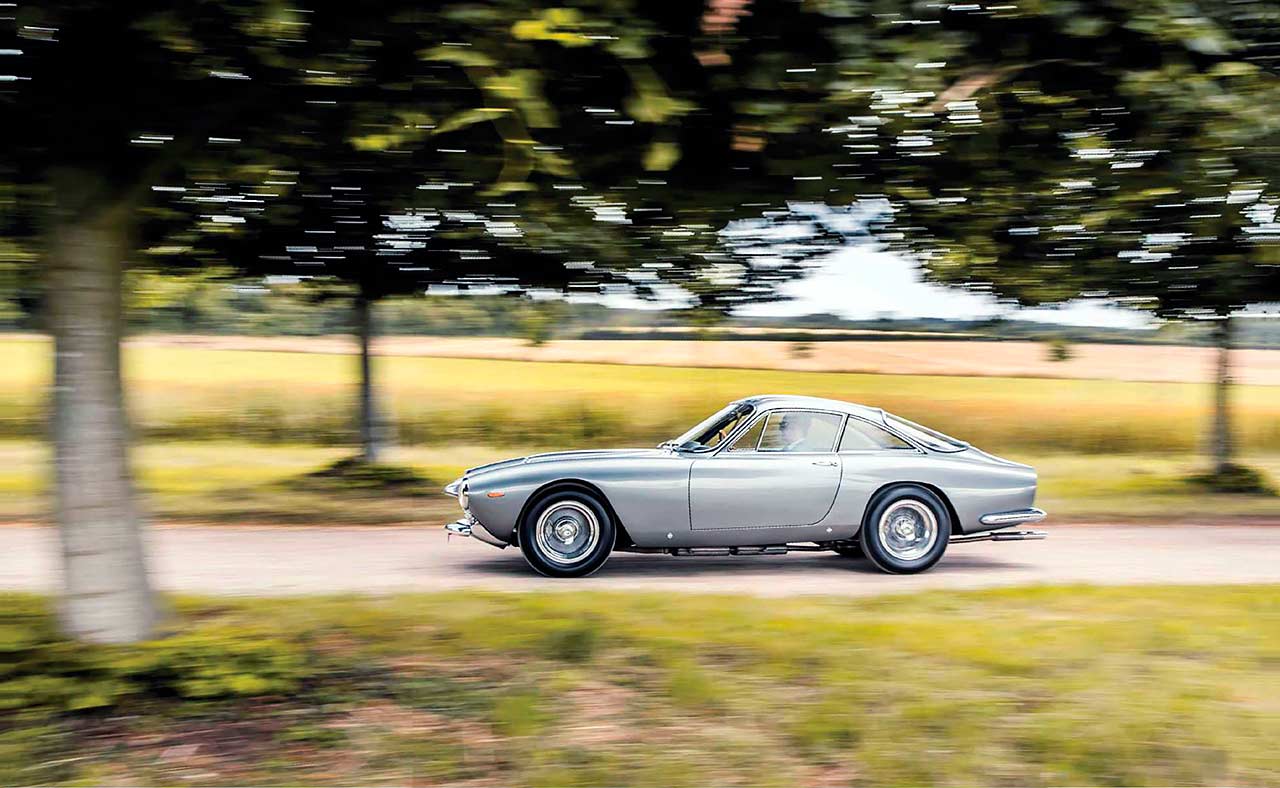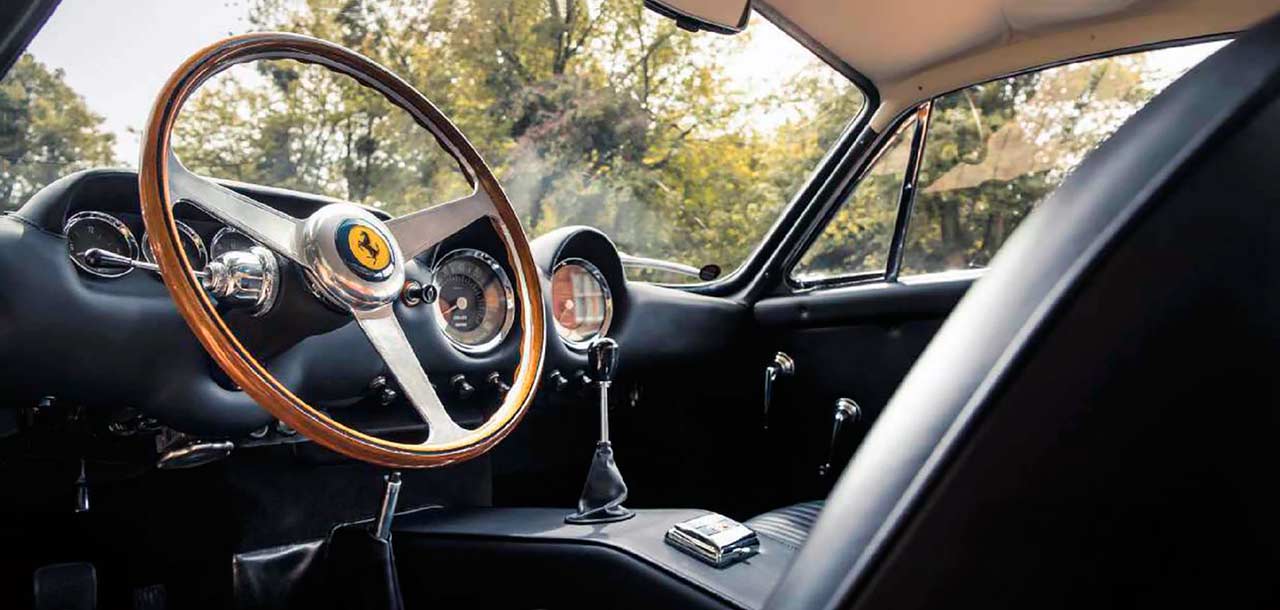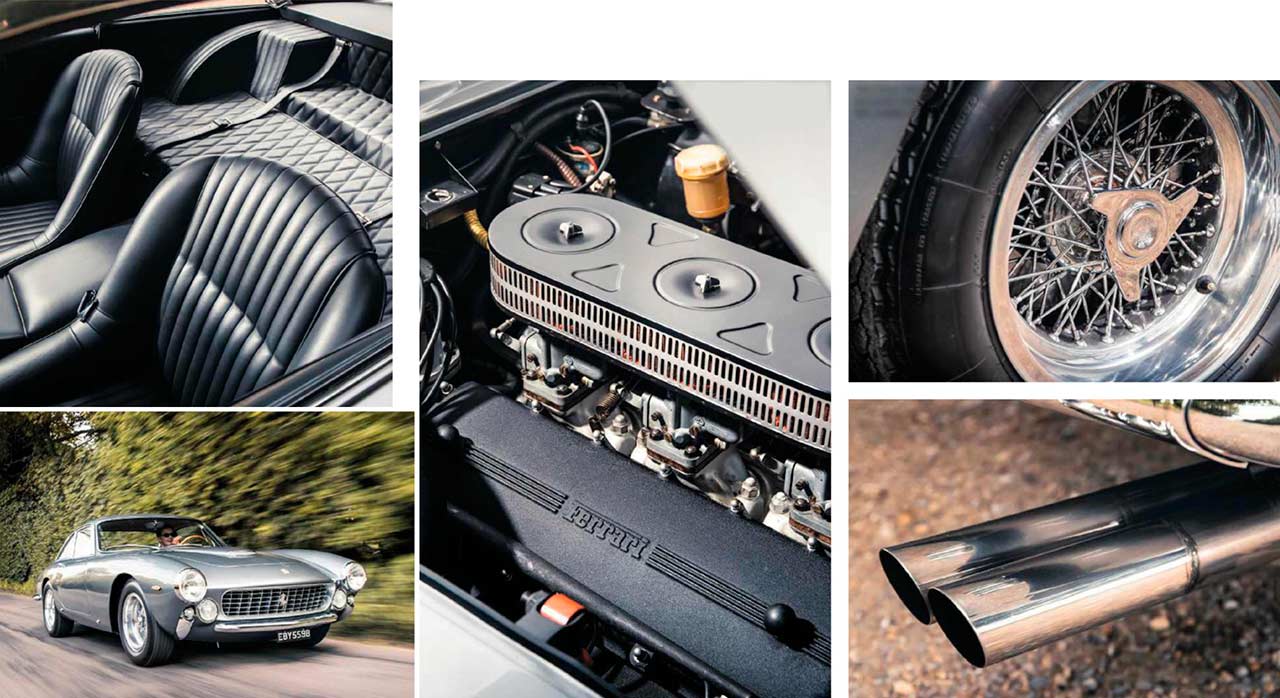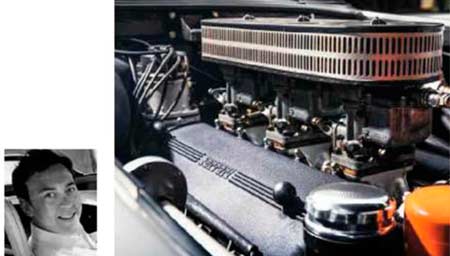
Ferrari 250 Lusso driven. Cover La Dolce Vita After driving a 250 SWB, Russ was left wondering why the gracious Ferrari 250 Lusso is deemed five times less valuable by the market. According to him, this was the perfect reason for him to take one for a drive… We recapture the heady days of mid-Sixties Rome by using this Ferrari 250 GT Lusso for what it was bought for to be driven. Words Russ Smith. Photography Jonathan Fleetwood.
The car sits idling gently in a nondescript Buckinghamshire trading estate. Surrounded by the usual collection of trucks, trailers and four-by-fours, spotting it is like a surprise encounter with Joanna Lumley in a Rotherham fish and chip shop. Clad in Grigio Fumo – which, typically of the Italian language, sounds like a top design label but simply means ‘smoke grey’ – the Ferrari 250 GT Berlinetta Lusso is elegance personified. Even that idle is little more than a murmur, with only the occasional stumble to hint at the V12 mayhem that waits to be unleashed.

This is a car with a big price on its head, though it falls well short of the numbers applied to other Sixties Ferraris. Only the truly decadent would call a car with a million-plus price tag a bargain, but all things are relative. Relative in this case refers to the likes of the Lusso’s slightly older and sportier 250 GT SWB brother, one of which would cost you at least five times as much as a Lusso. And don’t get me started on the now £35m-or-more 250 GTO that sold alongside the Lussos from 1962-64. Put in that context, the 250 GT Lusso looks suspiciously under-valued. In the highly scrutinised market for collectors’ Ferraris and their pecking order, there has to be a well-established reason. Is it a bit of a duffer, perhaps?
I rather hope that’s not the case. Despite never having driven one before, the 250 Lusso has become my stock answer to the regularly asked question, ‘What’s the classic you’d most like to own?’ The last of the 250-series Ferraris, there’s a purity to the lines of Pininfarina’s design that borders on perfection. The larger and more delicately pillared glasshouse than other 250s is what delivers the Lusso’s visual balance and height of good-taste elegance. This is complemented by various styling risks that shouldn’t work but do. Walk round a Lusso and you won’t find a bad angle to view it from. It almost doesn’t matter what it drives like, but experience with other V12 Ferraris told me that was unlikely to be an issue.
The first owner of this one certainly appeared to enjoy the driving her car. Chassis 5783 GT was delivered new to Maria Damasio in Rome on 6 July 1964, near the end of the model’s production run of 350 cars. By the time of its third service, just two years later, the Lusso had racked up 32,000 kilometres. That’s daily-driver territory, in the heart of the hedonistic early Sixties Rome depicted in Federico Fellini’s epic film La Dolce Vita, where the bored rich sought shallow pleasures while studiously wearing their sunglasses at night, and the height of decadence was actually not a Ferrari but a Cadillac convertible ‘the size of an apartment’.
Fifty years on we can find no trace, but it’s not hard to imagine Maria Damasio as one of the city’s socialites who was continually pursued by the paparazzi – a term that was actually derived from the name of a character in the movie. If so, the Lusso was perhaps the perfect tool on Rome’s then much-less-crowded roads for evading the hordes of Vespa-mounted photographers. We’re unlikely to find any of those on the streets of Amersham, but it’s nice to dream, and I don a pair of Ralph Lauren shades just in case.
The engine is well warmed up now so it’s time to slip – trying hard to look like I do it every day – into the beautifully leathertrimmed but unpretentious low-back bucket seat. This is so of its era and was widely copied (though in vinyl) for sale in Sixties speed shops. The same goes for the diamond-quilted black covering for the rear compartment’s luggage area, which featured in any number of hot rods and specials well into the Seventies.
Being buckets there’s no adjustment for the seat backs, but sliding mine a couple of notches forward on the runners puts me in what feels like a perfectly tailored driving position: arms at just the right angle for long-term comfort and control, pedals exactly where my feet want them, and when my right hand drops to the gear knob it’s on it without needing to look. Only the odd upright handbrake is a stretch and lean away beneath the dashboard. Leaning’s easy though, because there’s only a lap-belt fitted, possibly a hangover from the middle part of this car’s life which was spent in America. Getting into character, what crosses my mind is that at least the belt won’t crease my jacket, though I must sadly admit that was made in China, not Italy.
A blip of throttle brings a small shiver and a grin, then I slip the lever easily into first and head off in search of a tank of benzina because the gauge is hovering close to the zero mark. I’m immediately struck by how easy a car this is to drive. The whole legend that has grown up around Ferrari 250s suggests they are such highly strung thoroughbreds that the 250bhp 3.0-litre V12 will need an experienced jockey to tame it. Maybe it’s different at the limit, but at normal road speeds the reality is that it’s no harder to pilot than the Nineties Volvo I drove down in. The big difference is in the quality and amount of tactile feedback you get from the Ferrari’s controls. That and the free-revving engine’s enthusiasm that can quickly get you into trouble, compounded by the large and beautiful Veglia speedometer being in the right hand one of the two large binnacles in the centre of the dashboard, about 45 degrees from your line of sight and therefore virtually invisible once you do start to pile a bit of speed on.
The nearer one contains the rev-counter and is barely any more readable on the move. Enzo was obviously more concerned that the driver kept an eye on his beloved engine’s temperatures and oil pressure. Filled up with Super, it’s now time for the starting ‘event’. Come on, it’s a classic Ferrari, you’re not going to simply turn a key; there should be a bit of theatre. So the key is turned halfway until you hear the faint whirr of the fuel pump, boot the throttle pedal to dump some fuel into the inlets, then push and turn the key the rest of the 180 degrees to engage the starter. The resulting snarl turns every head in the busy Shell station, though truth be told this car is never short of an audience.
Out of town and onto some empty roads it quickly becomes clear that although the Lusso is happy to potter along at 1500rpm without temperament, it’s not a torquey motor and point-blank refuses to accelerate from such revs. You have to drop to whichever gear in the four-speed box puts at least 2500rpm on the (also hard to see) dial, and then all those horses can be turned loose. Which is exactly how you’d expect to drive a car like this and it produces a heavenly mix of thrust and music from the engine. Having run up like that through the gears just once I know why it appears that this car has never had a stereo fitted. Yes, it is a little noisy, but it’s the a sound you could never tire of, though maybe a fifth gear wouldn’t hurt for fast touring use.
The gearchange itself is meaty but precise, as is the clutch. I started to feel that in my left thigh after about an hour – it would probably be a bit sooner in Rome traffic – but it’s no worse than you’d find in other properly fast cars of this era like Astons or E-types. Some might take a while to adapt to the Ferrari’s floorhinged pedals but I have similar in my Alfa Spider so it felt normal.
What I really loved was the sculpted cutouts in the far side of the gear knob, designed to fit your two middle fingers and make you hold the knob the correct way. It was such a lovely detail and felt so right that I immediately wanted one for the Alfa. Other than the cutouts it’s just plain black plastic, but the perfect topping for the slim chrome stick protruding from the smallest possible leather boot. The Lusso’s interior looks all the more stylish for not having the traditional shiny open gate, and that minimalist vibe carries through the rest of the cabin – simple things done expensively, like the finely etched finish on the solid spokes of the black-lined woodrim steering wheel. It’s a work of art on its own and the kind of detail a moneyed Signora would appreciate.

Using that wheel is a delight, too. Even without rack-and-pinion, Italians are very good at turning out steering systems that are smooth and full of feel, and that’s exactly what you get in the Lusso. It’s never heavy, even at crawling speed, and doesn’t kick back over bumpy stuff. It combines perfectly with suspension that strikes a fine compromise between sporty and pliant – all the better to remain unruffled on period Italian roads, which could be far from smooth. There’s nothing clever about it – in fact there are still parallel leaf springs at the back – but this was old technology that engineers knew how to get the best out of. I follow a modern BMW 5 Series for a while and it’s picking its way slowly over speed bumps and potholes that the Ferrari barely registers.
When I do try pushing things a bit on some quiet twisties the Lusso remains composed and predictable. The photos later show that it lists a bit in a tight turn but it never feels like that from behind the wheel. And even though once up in the power band it snaps into action with the slightest throttle press, eager to leap forward, and the grip is well matched to the power on offer. The all-disc brakes are similarly reassuring. Of course on this age of car you don’t get the largest discs and calipers but it’s also not a heavy car and I’d put its stopping ability on par – again – with my Alfa Romeo.
It does take a while to get used to the absence of outside mirrors, but they would spoil those clean lines a little and it’s common to see Lussos without them. The other oddity is the row of seven switches spread across the underside of the dashboard for all the minor controls. From a practical point of view it’s plain daft – they point down and even if there are labels on their faces you can’t see them from the driver’s seat. For a first drive it’s awkward – I never do find the light switch – but you’d learn them over time, and it does so suit the clean, minimal style of the interior.
Feeling cheeky I try the high-end De Vere Hotel at Chesham for a break and backdrop. Turns out they are classic friendly – their corporate-logo’d Minor Traveller is sitting by the front steps – and are pleased to see the Ferrari. It has that supermodel effect on everyone and one De Vere boss, who stops by on the way to his brand-new Range Rover, gets so excited that for a moment I think we have a customer.
I take some time to drink in some more details, like the clean Kamm tail that carries the large round tail-lights that have remained a Ferrari trademark to this day – this was the first model on which they were used.
Then there’s the genius of Pininfarina’s design games. No-one in their right minds would think of fitting a car with a front bumper that’s only the width of the grille, then putting ‘over-riders’ on each wing beneath the sidelamps. Yet somehow it works and it’s impossible to imagine the Lusso any other way.
This is also one of few cars that has been styled and finished all the way underneath, beyond the visibility point. Look at most cars from ground level and you see seams, rusty jacking points and other untidy resolutions, but not here.
I hit some traffic on the way back, and once again the Lusso takes it all in its stride. It gets hot but not too hot, and doesn’t get cranky with it. A dual-carriageway blast quickly settles all the gauges back to normal levels, and restores the grin to my face that’s been there for most of the day. I’ve met one of my heroes and not been disappointed in any way I couldn’t easily forgive. I can also now make a direct considered comparison between the 250 Lusso and the five-times-as-expensive 250 SWB I drove previously. Even if they were of equal value, the Lusso is the car I wish I could be bidding on at the RM Sotheby’s auction in September. It’s no wonder Signora Damasio enjoyed it to the full. It must have been quite a sight – and certainly a rare one – in mid-Sixties Rome when Alitalia planes still had propellers and a TR3A could still be a cool man-about-town’s car.
To sum up, this isn’t a Ferrari that dazzles with numbers. It doesn’t do anything better than its stablemates but the sum of its parts and Pininfarina styling mastery add up to what I believe is the most complete, desirable and usable classic car there is. For me, at least. The 250 Lusso really does deliver The Sweet Life (La Dolce Vita). But it has aged immeasurably better than Fellini’s film. With thanks to RM Sotheby’s, which will auction this car in Maranello in September, Torque Agency Group and DK Engineering.
Tech and photo
TECHNICAL DATA FILE SPECIFICATIONS 1964 Ferrari 250 GT Lusso
Engine All-alloy 2953cc V12, sohc per bank, three Weber 32DCS twin-choke carburettors
Power and torque 250bhp @ 7000rpm; 188lb ft @ 5500rpm (DIN)
Transmission Four-speed manual, rear-wheel drive
Steering Worm and sector
Suspension Front: independent by double wishbones, coil springs, telescopic dampers and anti-roll bar; Rear: live axle with semi-elliptic leaf springs and telescopic dampers
Brakes Dunlop discs all round, servo-assistance
Weight 1312kg (2889lb)
Performance Top speed: 149mph; 0-60mph: 7.9sec
Fuel consumption 17mpg
Cost new £5607
Value now £1m-£1.5m
{module Ferrari 250}
{module 1963 Ferrari 250 GT Berlinetta Lusso Pininfarina}
‘It was the perfect tool for evading Rome’s Vespamounted paparazzi’
‘The Colombo V12 is not a torquey motor and point-blank refuses to accelerate from less than 2500rpm’
‘It must have been quite a sight in mid-Sixties Rome, when Alitalia airplanes still had propellers’



250 LUSSO REALITIES
So you’ve got a million or so to invest in a 250 GT Lusso. But what are they like to look after and get parts for, and what is it likely to cost to run one? We asked James Cottingham of DK Engineering to spill the beans. ‘They’re strong and durable cars. If one has been well restored and maintained you should only need to carry out annual servicing. Every few years that will need to include setting up the carburettors, brakes and suspension – a fine art. But on average you should get change out of £2000 for annual servicing.
‘From the Sixties all 250-series Ferraris were similar mechanically, which has helped with the parts situation; and there’s a good worldwide network for them. Ferrari keeps a good stock of parts and when something becomes needed someone will make it.

‘The key is to buy the right car in the first place. You want something that’s never been accident damaged, so a complete history file is important. Look out for corrosion, of course, and don’t buy a Lusso without carrying out a compression test, because that’s the first sign of engine issues and putting those right will be expensive.’






